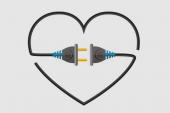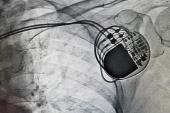His-bundle Pacing, TAVI Advice Debut in ESC’s Update to Pacing, CRT Guidelines
Many recommendations from 2013 have become “obsolete,” said guideline cochair Michael Glikson, paving the way for change.

Much has happened in the field of cardiac pacing and cardiac resynchronization therapy (CRT) since 2013, and that’s reflected in updated guidelines from the European Society of Cardiology (ESC), released during its recent virtual meeting.
Among the revisions, the document introduces new modalities like His-bundle and leadless pacing; expands recommendations for CRT; gives TAVI its own section; provides a list of metrics that can be used to aid quality-improvement efforts; and puts fresh spotlights on the evaluation of candidates for pacing and on the importance of patient-centered care and shared decision-making.
There was a lot of obsolete information in the 2013 iteration, according to Michael Glikson, MD (Shaare Zedek Medical Center and Hebrew University, Jerusalem, Israel), one of the chairs of the guidelines task force along with Jens Cosedis Nielsen, MD, PhD (Aarhus University Hospital, Denmark).
“So we define new groups and new indications,” he told TCTMD, adding the “most-dynamic field” is conduction-system pacing, which includes His-bundle and left bundle branch area pacing. “Over the next few years, we will see changes, we will see expansion of indications, and we will have more and more patients who are currently regular pacemaker candidates” get treated with one of these pacing types, he said.
More on CRT
Glikson reviewed some of the major changes for TCTMD, pointing to new sections on sex differences in pacing indications and complication rates, as well as on the evaluation of patients for pacing. The latter section includes discussion and recommendations around the history and physical exam, ECG, noninvasive evaluations, implantable monitors, and electrophysiology studies.
The authors also expanded the CRT section, providing a new class I (level of evidence A) recommendation for use of a CRT-defibrillator (CRT-D) in patients who are candidates for an implantable cardioverter-defibrillator and who have a CRT indication, stating that implantation of a CRT-D should be considered after individual risk assessment and shared decision-making (class IIa, level of evidence B).
Also, in patients with symptomatic atrial fibrillation and an uncontrolled heart rate who are candidates for atrioventricular junction ablation, regardless of QRS duration, CRT is preferred over standard RV pacing in patients with heart failure and mildly reduced ejection fraction (class IIa, level of evidence C). For patients with heart failure and preserved ejection fraction, however, RV pacing should be considered (class IIa, level of evidence B) and CRT may be considered (class IIa, level of evidence B).
Referring to the process behind development of the guidelines, Glikson noted that “the most-vivid discussions were on CRT because this is an issue that lies between electrophysiology and heart failure.” Extensive efforts were made, he added, to ensure that recommendations were aligned between the pacing/CRT guidelines and new ESC heart failure guidelines that came out a few days earlier.
Where His-Bundle Pacing Fits
Another somewhat controversial area for the guideline writers, Glikson indicated, was alternate-site pacing, particularly His-bundle pacing, for which evidence is still limited. “There is no evidence base for His-bundle pacing, although many people do it, and we thought that it’s probably premature to be included as a class I or class II indication. So we left it only for patients who fail CRT and otherwise for patients with ejection fraction that is above [the threshold for] CRT but below normal—they may benefit from His-bundle pacing instead of RV apical pacing, but we gave it a [class] IIb indication because the jury is still out.”
Specifically, the authors say His-bundle pacing should be considered as an option along with others, like use of a surgical epicardial lead, in CRT candidates in whom implantation of a coronary sinus lead is unsuccessful (class IIa, level of evidence B). And it may be considered as an alternative to RV pacing in patients with atrioventricular block and an LVEF above 40% who are expected to have more than 20% ventricular pacing (class IIb, level of evidence C).
No recommendations are yet given for left bundle branch area pacing, but Glikson anticipates a lot of movement within the field of conduction-system pacing in the coming years. “We need more randomized controlled trials and more comparisons, because it seems like the next [major] thing—as we were 20 years ago with CRT,” he said. “But we don’t know yet, so this is certainly the most-important part for future research.”
The section on alternate-site pacing also provides two new recommendations regarding leadless pacing, which is becoming more and more common, Glikson said. Leadless pacemakers should be considered as an alternative to transvenous pacemakers when no upper-extremity venous access exists or when the risk of device-pocket infection is particularly high (class IIa, level of evidence B), according to the guidance. Also, they may be considered as an alternative to standard single-lead ventricular pacing after taking into account life expectancy and using shared decision-making (class IIb, level of evidence C).
Greater Focus on TAVI and Other Changes
In the 2013 version of the guidelines, TAVI was lumped together with cardiac surgery and heart transplantation for the discussion on pacing implications, but it has become apparent over the past several years that it is worthy of its own section. “In the last version of the guidelines, TAVI was regarded as if it was an operation, like surgery for AVR, but it’s totally different, and the conduction problems following TAVI are fairly common. It was a very pertinent issue, so we built a whole new section on post-TAVI pacing,” Glikson explained.
That section includes new class I recommendations for permanent pacing in patients with complete or high-degree atrioventricular block lasting 24 to 48 hours after TAVI (level of evidence B) and in patients with new-onset alternating bundle branch block after the procedure (level of evidence C). There is also a class III recommendation against prophylactic permanent pacemaker implantation before TAVI in patients with right bundle branch block and no indication for permanent pacing.
Other changes in the guidelines include an additional focus on pacing in the setting of cardiac surgery and in patients with diseases of the tricuspid valve and new or expanded sections on complications, special considerations for device implantation and perioperative management (including anticoagulation), and management considerations. That last topic covers MRI, radiotherapy, temporary pacing, the perioperative period, sports activity, the determination of when pacing is no longer indicated, and device follow-up.
The document also includes a new section focused on the importance of involving patients in treatment decisions, with a table covering topics that may be included in patient education. “The whole profession of medicine is moving toward patient-centered care,” Glikson said. “We made sure that everything that is not clearly indicated by the guidelines should be discussed with patients using shared decision-making. For indications that are not very strong, or when you have a choice between different modes of pacing or different devices, we insisted and included it in the guidelines that patients should be consulted about medical decisions in the field.”
Todd Neale is the Associate News Editor for TCTMD and a Senior Medical Journalist. He got his start in journalism at …
Read Full BioSources
Glikson M, Nielsen JC, Kronborg MB, et al. 2021 ESC guidelines on cardiac pacing and cardiac resynchronization therapy. Eur Heart J. 2021;Epub ahead of print.
Disclosures
- Glikson reports travel/meeting support from Boston Scientific and Sorin Group; and institutional research funding from Biotronik, Medtronic, and Pfizer.
- Nielsen reports institutional research grants from the Novo Nordisk Foundation and membership in the Danish Heart Foundation.





Comments